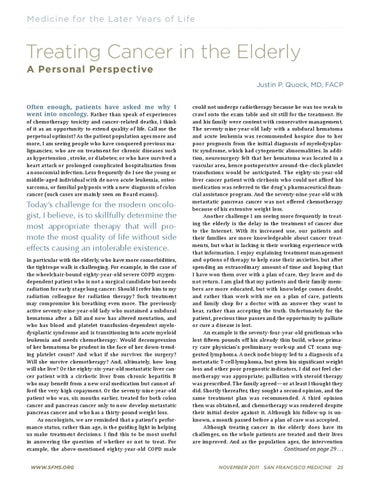Medicine for the Later Years of Life
Treating Cancer in the Elderly A Personal Perspective Justin P. Quock, MD, FACP Often enough, patients have asked me why I went into oncology. Rather than speak of experiences
of chemotherapy toxicity and cancer-related deaths, I think of it as an opportunity to extend quality of life. Call me the perpetual optimist? As the patient population ages more and more, I am seeing people who have conquered previous malignancies; who are on treatment for chronic diseases such as hypertension , stroke, or diabetes; or who have survived a heart attack or prolonged complicated hospitalization from a nosocomial infection. Less frequently do I see the young or middle-aged individual with de novo acute leukemia, osteosarcoma, or familial polyposis with a new diagnosis of colon cancer (such cases are mainly seen on Board exams).
Today’s challenge for the modern oncologist, I believe, is to skillfully determine the most appropriate therapy that will promote the most quality of life without side effects causing an intolerable existence.
In particular with the elderly, who have more comorbidities, the tightrope walk is challenging. For example, in the case of the wheelchair-bound eighty-year-old severe COPD oxygendependent patient who is not a surgical candidate but needs radiation for early stage lung cancer: Should I refer him to my radiation colleague for radiation therapy? Such treatment may compromise his breathing even more. The previously active seventy-nine-year-old lady who sustained a subdural hematoma after a fall and now has altered mentation, and who has blood and platelet transfusion-dependent myelodysplastic syndrome and is transitioning into acute myeloid leukemia and needs chemotherapy: Would decompression of her hematoma be prudent in the face of her down-trending platelet count? And what if she survives the surgery? Will she survive chemotherapy? And, ultimately, how long will she live? Or the eighty-six-year-old metastatic liver cancer patient with a cirrhotic liver from chronic hepatitis B who may benefit from a new oral medication but cannot afford the very high copayment. Or the seventy-nine-year-old patient who was, six months earlier, treated for both colon cancer and pancreas cancer only to now develop metastatic pancreas cancer and who has a thirty-pound weight loss. As oncologists, we are reminded that a patient’s performance status, rather than age, is the guiding light in helping us make treatment decisions. I find this to be most useful in answering the question of whether or not to treat. For example, the above-mentioned eighty-year-old COPD male www.sfms.org
could not undergo radiotherapy because he was too weak to crawl onto the exam table and sit still for the treatment. He and his family were content with conservative management. The seventy-nine-year-old lady with a subdural hematoma and acute leukemia was recommended hospice due to her poor prognosis from the initial diagnosis of myelodysplastic syndrome, which had cytogenetic abnormalities. In addition, neurosurgery felt that her hematoma was located in a vascular area, hence postoperative around-the-clock platelet transfusions would be anticipated. The eighty-six-year-old liver cancer patient with cirrhosis who could not afford his medication was referred to the drug’s pharmaceutical financial assistance program. And the seventy-nine-year-old with metastatic pancreas cancer was not offered chemotherapy because of his extensive weight loss. Another challenge I am seeing more frequently in treating the elderly is the delay in the treatment of cancer due to the Internet. With its increased use, our patients and their families are more knowledgeable about cancer treatments, but what is lacking is their working experience with that information. I enjoy explaining treatment management and options of therapy to help ease their anxieties, but after spending an extraordinary amount of time and hoping that I have won them over with a plan of care, they leave and do not return. I am glad that my patients and their family members are more educated, but with knowledge comes doubt, and rather than work with me on a plan of care, patients and family shop for a doctor with an answer they want to hear, rather than accepting the truth. Unfortunately for the patient, precious time passes and the opportunity to palliate or cure a disease is lost. An example is the seventy-four-year-old gentleman who lost fifteen pounds off his already thin build, whose primary care physician’s preliminary work-up and CT scans suggested lymphoma. A neck node biopsy led to a diagnosis of a metastatic T-cell lymphoma, but given his significant weight loss and other poor prognostic indicators, I did not feel chemotherapy was appropriate; palliation with steroid therapy was prescribed. The family agreed—or at least I thought they did. Shortly thereafter, they sought a second opinion, and the same treatment plan was recommended. A third opinion then was obtained, and chemotherapy was rendered despite their initial desire against it. Although his follow-up is unknown, a month passed before a plan of care was accepted. Although treating cancer in the elderly does have its challenges, on the whole patients are treated and their lives are improved. And as the population ages, the intervention
Continued on page 29 . . .
November 2011 San Francisco Medicine
25
